Gamera 2: Attack of Legion, Gamera 3: Revenge of Iris, Gamera the Brave, Gamera the Guardian of the Universe (1995, 1996, 1999, 2006)
Directed by: Ryuta Tasaki, Shûsuke Kaneko
Written by: Kazunori Ito
Starring: Al Maeda, Ayako Fujitani, Ryo Tomioka, Shinobu Nakayama
So here I continue with my review of the films and discs in Arrow Video’s Gamera: The Complete Collection boxset.
DISC FIVE:
GAMERA THE GUARDIAN OF THE UNIVERSE [1995]
RUNNING TIME: 96 mins
A series of mysterious incidents around the Philippines seems to be the work of an atoll with amulets and a stone slab covered in runes that’s heading for Japan. While scientists led by Naoya Kusanagi investigate this, ornithologist Mayumi Nagamine looks into reports of bird-like creatures, leading to a failed government attempt to capture them at the Fukuka baseball stadium. The atoll is actually Gamera and he kills one of the ‘birds’, but the others have disappeared. Translation of the runes reveals an ancient prophecy possibly coming true, while Yonemori’s daugher Asagi forms a spiritual bond with Gamera….
I remember when Gamera The Guardian Of The Universe came out; even in the UK it got a very limited cinema release and surprisingly positive critical response. I was even able to go and see it. While the splash it made was brief like most non-American kaiju movies, it still got much more exposure than all the films in the Godzilla Heisei that ran from 1984 to 1995 except for the first, The Return Of Godzilla, and quickly became widely regarded as one of the best kaiju movies ever. There are four or five Toho pictures which I personally prefer, but it’s certainly an absolute cracker, a lightning paced 96 minutes that hardly ever pauses for breath and gives us plenty of great moments, at times genuinely showing off with its much improved special effects. And it’s also a complete overhaul of the Gamera franchise, and not just because it starts the chronology afresh [the Godzillas followed on from Godzilla and ignored the ones in between]. While it does feature a young girl [though not as young as the kids in the Showa Gamera efforts], the tone is serious but not totally serious; there’s a slight knowing quality in the writing without becoming smug. Plot-wise it may have inspired the 2018 American Godzilla. Returning with the more menacing looking Gamera, who now breathes fire balls instead of just fire is Gyaos, or rather three of them; he was the scariest of Gamera’s old adversaries, and here he – or maybe she – has been slightly redesigned to look much more like a plausibly living creature, and are mostly realised by puppets and models until the final third in a film that’s a real showcase for old school special effects at their very best.
While the human characters are believable if not particularly memorable despite the presence of Steven Segal’s daughter Avako Fujitani as the young girl Akagi, the equal balancing of the two plot lines in the first third is expertly handled by director Shusuke Kaneko, building things up rapidly. There are some great edits, like when Mayumi says, “Who do I have to see”, after which we immediately cut to some men around a table staring at her. One moment has Gyaos carry off and presumably eat a dog; we don’t see it but the fact that it happens at all is a surprise. Kiddie fare this isn’t. The Gyaos initially aren’t that big but one of them eventually grows to a huge size. Gamera is of course back to being a destroyer, though instead of continuous model work, many of his scenes expertly matte him in to real city footage, meaning that we lose out on some full-on destruction but gain a stronger sense of realism. For once the army can’t help at first because it’s forbidden to attack and needs to be allowed by the government to do so. While the first time that Gamera flies is kind of wasted compared to how it was done in 1965, the fights manage to both be thrilling and seem like living creatures actually having life or death struggles. Some early CG shots, including some dreadful missiles, aren’t too good, but one would expect that to be the case. The final showdown features model work the equal of Toho’s efforts of the time, and climaxes in some jaw-dropping shots of the camera following Gamera and Gyaos from space back down to Earth, a scene riffed on in Pacific Rim and Godzilla King Of The Monsters. It’s amazing what special effects director Shinji Higuchi was able to pull off despite the budget being lower than the Heisei Godzillas by nearly two thirds.
In fact for once some slightly artistic shots are attempted by cinematographer Junichi Tozawa, like an awesome one of Gyaos perched atop a wrecked Tokyo Tower while the sun sets, the new king unless Gamera can save the day. There seems to be some homage to Ishiro Honda’s work, even down to single shots like a replication of the first sight of Terror Of Mechagodzilla‘s Katsura, while the script by veteran anime writer Kazunori Ito does appear to borrow from some Toho efforts, including the 1974 version of Godzilla Vs Mechagodzilla‘s monster prophecy and Godzilla Vs Mothra‘s idea of an ancient civilisation contending with monsters, though he cleverly gives us something of an explanation for why Gamera and Gyaos [and by dint all the previous creatures] are so odd; they may have been genetically created by ancient Atlantians. He gives us some potential pathways for sequels to go down – some of which they did, some of which they didn’t, and even the environmental theme is wielded into the narrative rather well. Kow Otani’s music score could be louder but contains some solid themes. Gamera The Guardian Of The Universe is pretty downright awesome and, despite it not containing Godzilla, is a perfect movie to introduce newcomers to the wonderful world of kaiju.
Rating: 









SPECIAL FEATURES
High Definition (1080p) transfer of Gamera the Guardian of the Universe, from a 4K restoration by Kadokawa Pictures, with original Japanese and dubbed English DTS-HD MA 5.1 and 2.0 audio, with optional English subtitles
One would probably expect the Heisei films to look better than the Showa films, and this one certainly does, with a strikingly crisp and well balanced restoration that does especially well by the many night time scenes. The majority of the opticals hold up very well. Arrow have included both the American and the English dubs; the American one comes across better because more of an attempt was made to match the lips of the performers, though it’s not as close to the original script. And YES!!! – Arrow have included the UK version that came out on video with techno music added. The tracks are mostly randomly placed over the film, but seeing as I – sorry – actually love this kind of music and even some of the artists that we hear, I quickly became a fan of this version. Rave on, Gamera!
Audio Commentary by Kaiju artist Matt Frank
Matt Frank did the artwork for this set, so it’s nice that he gets to do an audio commentary, and it’s as packed with information as any of August Ragone’s. We learn that original Gamera series writer Niisan Takahashi and director Noriaki Yuasa were originally intended to make the new movie and planned Gamera Vs. The Phoenix before a semi-remake of Godzilla Vs. Gyaos was decided upon by Daiei, how there was endless arguing about the film’s tone and the fierceness or not of the new Gamera, and how the sight of dismembered Gyaos was realised by the bones of eaten chicken wings dried, fed to ants and glued together. Frank is clearly full of enthusiasm which occasionally gets the better of him with a bit of goofing around, but never mind. A very fine track.
Introduction by Japanese cinema expert August Ragone [4 mins]
It’s a surprise that Ragone’s introduction for this is so brief, but I guess he heard Frank’s commentary which pretty much says it all.
“A Testimony of 15 Years: Part 1” 2010 documentary interviewing the cast and crew of the Heisei Trilogy [115:46], in Japanese with English subtitles
This is the first part of a massive retrospective Japanese documentary which interviews no less than 98 crew members of the Heisei films, though the whole thing might be best watched once one has seen all three, seeing as it does refer to and show clips from all of them and in the process gives some things away. We hear that the filming of the petrol-chemical plant explosion disturbed the locals who even got soot on their washing, have one interviewee who won’t let himself be seen [the camera focuses on his dog] nor identified while he talks of writing a script [I think], and have another admit that he didn’t work very hard so wasn’t asked back for the sequels. Nice to see some who don’t like monster movies talk fondly of the film’s making. All in all a bit exhausting but never uninteresting.
2002 interviews with director Shusuke Kaneko & special effects artist Shinji Higuchi conducted by filmmaker Jörg Buttgereit [35:48], in Japanese with English subtitles
Kaneko discusses the issue of the military [it’s actually true that they wouldn’t be able to attack a kaiju without having to do through much red tape], how little girls in Japan tend not to like these movies because little boys tend to scare them with imitations of monster noises, and a few other things, while Higuchi shows off a garage full of costumes and talks about some of the special effects. Surprisingly little overlap with what we’ve already heard here.
Interview with special effects artist Shinji Higuchi [92:42], in Japanese with English subtitles
This very lengthy interview, originally on the Daiei/Toshiba Video Japanese DVD, was split into three on the ADV DVD set of the three films. it was obviously made when Gamera 3 was coming out – hence more spoilers! After a comical if rather laborious beginning when Higuchi and the guy interviewing him pretend not to look each other, we get into an incredibly detailed chat delving especially deeply into the special effects; apparently the smoke we see when Gamera takes off in Gamera 2: Advent Of The Legion was put there because Higuchi didn’t think such shots looked convincing in the first film, and that an underwater battle was planned for that film until Mothra 2 beat them to it. We even get to see a failed collapse of Tokyo Tower, plus other cool behind the scenes stuff.
Behind the Scenes [16:01], in Japanese with English subtitles
Mostly new footage to this disc, set to rock music. This and the following four extras were on the ADV disc.
1994 Production Announcement (5:05, in Japanese with English subtitles)
Higuchi seems very sure of himself here, though apparently he made up his words on the spot.
Backstage Clip: “The Legend” [4:17], in Japanese with English subtitles
More behind the scenes stuff.
1995 Yubari International Fantastic Adventure Film Festival Unveiling [6:13], in Japanese with English subtitles
It’s fun to see young Avako Fujitani interviewing Kaneko and Higuchi here.
Hibiya Theater Opening Day Footage [2:55], in Japanese with English subtitles
Another nice little tidbit.
Additional English Credits [7 mins]
Theatrical and Promotional Trailers [7 mins]
Image Gallery [1 mins]
GAMERA 2: ATTACK OF LEGION [1996]
RUNNING TIME: 99 mins
On the night of a meteor shower, while out on field trip, science teacher Midori Honami and her group of kids see a particularly huge meteor plunge into the mountain snow. It contains insectoid aliens who set up a hive underneath Sapporo and cause a plant to grow into the city and spread all over the place. As oxygen levels increase, Colonel Watarase of the Self Defense Force and Miss Honami realise that the aliens are building a huge biological launchpad; the increased oxygen will aid the creatures in exploding a huge flower, catapulting its seed into space so that they can colonize yet another world. Can Gamera stop this….
Even before somebody quotes a relevant prediction from The Book of Revelations, there’s a real apocalyptic feel to this entry, which ranks alongside the 1954 Godzilla as the darkest of kaiju movies as well as seeming to be more influenced greatly by ’50s sci-fi/horror films, some of it following the template for many of them. Gamera The Guardian Of the Universe took itself fairly seriously, yet was still able to be a fun romp. Gamera 2: Attack Of The Legion takes itself even more seriously, and there’s nothing inherently wrong with that, nor with it attempting to scare even more at times. Sometimes it feels as if writer Kazunori Ito and director Shusuke Kaneko, both returning from the previous movie, saw Godzilla Vs. Destroyah and thought that they could improve on certain elements of it, which they definitely succeeded in doing, especially in terms of the antagonist[s]. The many small, one-eyed alien/insect-like Legions, resembling the creatures in Starship Troopers, are very articulate and convincing as suitmation creatures, while the one big man-in-suit Legion is a striking creation. Gamera has been redesigned again and now looks far more turtle-like, with a smaller head and webbed feet. Yet I think that the film falls a little short of its immediate predecessor, with a script that’s not always clear, and with far less of an actual story line, though it possibly outdoes it for sheer spectacle.
We really are in horror movie territory for a while with the early incidents involving the Legion; a shadow and a close-up of an eye when two security guards – one of them Osako from the previous film who’s gone for a less trying job – hear some strange noises, a driver of an underground train stopping and getting out to investigate after seeing lots of mess, the massacre of a group of soldiers sent in. The amount of human blood spilt is minimal but still more than usual [it’s normally just monster blood we see]. There’s even some Predator-style monster vision, while lines like, “prolonged exposure to such an environment brings a bad reaction; coughing, sore throat and respiratory problems” can’t help but provide a more ominous aspect than would have been intended back in 1996, though what’s with those early freeze frames? This kind of stylisation works in some kinds of films, but is just distracting in one like this. The sight of huge plants erupting out of skyscrapers is memorable and Gamera’s first major scene has him partly shrouded in darkness, something that actually makes the big turtle a little bit frightening, though his first encounter with Legion contains some shots where it’s hard to tell exactly what’s happening. And there’s a lot about Legion that’s vague; while we shouldn’t need everything to be explained to us, it would have been nice if we understood why, for example, loads of little Legions made one big Legion for just one scene. Ito prefers to have constant action, with all dialogue scenes cut to the bone, as Legion and her plants wreck everything, notably nearly all of Sendai in a huge explosion in a very impressive moment, and Gamera tries to stop her.
Watarase and Midori Honami make for a likable human team [a parting scene is lovely the way it slightly hints at a possible romantic element], and Asagi is still bonded to Gamera and now reminding us even more of Miki Saegusa in the Heisei Godzillas, though why is she not cut when Gamera is wounded as in the first film? The final showdown consists too much of both creatures just firing their weapons at each other Heisei Godzilla film-style, even though Legion’s whip laser is seriously cool, while Gamera seems to win in a very contrived and hastily thought-up way, though it’s explained somewhat in the third movie. Gamera’s blue blood really flows here, while twice the film wickedly introduces to us children who like Gamera, and who we think might become important, then forgets about them. This really reminds us of how different the series is now to how it once was. The special effects are the best yet all-round; even the matting, a device that invariably looks iffy when seen in High Defintion, looks substantially improved only a year on. Except for a thankfully brief crappy digital Gamera which doesn’t look much like the suitmation one, the bits of CGI look better too; it’s quite obvious that, even if you didn’t know, this one had a bigger budget. It’s an often epic show, even if I found it marginally less involving.
Rating: 









SPECIAL FEATURES
High Definition (1080p) transfer of Gamera 2: Attack of Legion, from a 4K restoration by Kadokawa Pictures, with original Japanese and dubbed English DTS-HD MA 5.1 and 2.0 audio, with optional English subtitles
The colours are tremendous in this restoration, they really pop out at you.
Audio Commentary by KaijuCast Controller Kyle Yount
Yount says right at the beginning of his commentary that he will provide lots of biographies, so you can’t say that he doesn’t warn you. Despite this, they tend to be brief, and he provides other kinds of information, such as how the Legion Flower scene is virtually a restaging of part of an episode of the series Ultra Q, the religious symbolism, and, most interesting some stuff about the Japanese Army that I never knew. Apparently they were happy to stage exercises to be filmed by kaiju movie directors until Godzilla Vs. Mothra‘s having them attack an unproved ally [Mothra] annoyed them, and a scene from Gamera The Guardian Of The Universe had to be cut before their cooperation. Yount has as lively a style as Matt Frank even though his talk track isn’t really as good.
“Lake Texarkana” comedic dub track
This probably seemed like a great idea when its producers were drunk. The film has been re-dubbed with hillbilly-style voices, following the script closely but with frequent supposedly funny comments thrown in like, “yeah, that guy’s as dumb as a new set of tires in Alabama” and scene transitions scored by a harmonica. It wears thin very quickly and this is one rare special feature in this set that I struggled to get through in its entirety.
Introduction by Japanese cinema expert August Ragone [4 mins]
Another brief introduction by Ragone. Was he pushed for time when he did these ones?
“A Testimony of 15 Years: Part 2” 2010 documentary interviewing the cast and crew of the Heisei Trilogy [121 mins], in Japanese with English subtitles
Yes, the second part of this mammoth talking heads documentary is two hours long, but I was engrossed even though a few people do basically repeat what others say. We hear from more effects bods and about a great deal of things; the main Legion costume continually falling apart and being held together by wire in the climactic scenes, how it was hard with two people inside the suit as one kept falling on the other, how one of the producers Naoki Sato was disappointed with the second film so didn’t return for the third which he wasn’t too keen on, and so forth. Lots of honest opinions here.
Behind the Scenes: Production Footage [59:54], in Japanese with English subtitles
These ‘fly on the wall’ types of special features are among my favourite kind; give me this over a quickly edited documentary any day. Here we see most of the notable non-special effects scenes being filmed. This and the next feature are exclusive to DVD/Blu-ray.
Behind the Scenes: Special Effects Footage [39:46], in Japanese with English subtitles
More of the above, except that this one is devoted to effects scenes. We see exciting footage [well, it was exciting to me, anyway] of the Legion costume being put together, two people being pulled along the floor [supposedly by a Legion creature] and accidentally being slammed into the operation part of the pulling device, and a strange ceremony involving throwing beans at a demon. Not a dull moment.
1995 Production Announcement [6:34], in Japanese with English subtitles
Some members of the cast and crew big up the film, and we hear that lots of fans of the older Gameras who were initially sceptical of the revival clamoured for a sequel, how Japanese cinema of the time was dominated by anime and kaiju movie, and learn that snow is taboo in one of these films [is it?!]. This and the following extras were on the ADV DVD.
Backstage Clip: “Sky” [3 mins], in Japanese with English subtitles
Another montage of mostly new [to this set] behind the scenes footage set to a pop song.
Promotional Events Footage 6 mins], in Japanese with English subtitles
Some tours round three promotional events, with much footage of models, suits, and kids having a whale [of should that be a turtle?] of a time.
1996 Hibiya Theater Opening Day [4 mins]
Cast and crew again bigging up the film, notably warning that it’s scary.
Additional English Credits [1 min]
Comedy Dub Outtakes [3 mins]
Well I did chuckle once!
Trailers & TV Spots [13 mins]
Image Gallery [2 mins]
DISC THREE:
GAMERA 3: REVENGE OF IRIS [1999]
RUNNING TIME: 109 mins
Mayumi Nagamine returns to aid the Japanese government in addressing a new threat. Gyaos are now Hyper Gyaos and plague Japan again while a graveyard of Gamera fossils is found at the bottom of the sea and occultist Miss Asakura – who believes Gamera to be an evil spirit – and Kurata Shinya are secretly working with the government to destroy Gamera. When Gamera kills two Gyaos, it’s at the cost of between 15 and 20,000 lives. Meanwhile young Ayana, whose parents were killed by Gamera in 1995, forms a link with a small tentacled creature that hatches from an egg she found in a temple. She wants to raise it to kill Gamera….
As I type, I can’t decide which I like better; Gamera Guardian Of The Universe, or this conclusion to what is a damn fine trilogy, whose world building, partly rooted in Chinese Mythology, must have inspired aspects of the Legendary Monsterverse. The earlier film is faster paced, has more action sequences, much more of Gamera, and more agile fights, things that would normally put it way ahead. But the later movie ties together all three films in a really fine way while still leaving much that’s delightfully vague [if this was an American film we’ll probably have lots of laborious explaining almost grinding things to a halt], it’s more thoughtful, mystical and plays with and even subverts some kaiju movie conventions so much that it’s virtually a commentary on the genre while also taking closer to the world of anime even more than Godzilla Vs. Biollante. It’s even more rooted in apocalyptic fear, exploiting that end of the world feeling that was around in 1999. Oh, and it has Iris, the most magical and fantastical of Gamera’s adversaries, a weird and wonderful combining of a Gyaos, an octopus and a crab [and it even looks like a Transformer from the distance in one of its early stages!] its four mile-long tentacles all ending in spikes that can fire a sonic beam while its arms contain retractable spikes that suck blood. Even when rendered as a CG creation for the scenes when its flying, Iris is an incredible creation.
After a prologue when a dead Gyaos is found after causing much death in Africa, the titles play against black and white footage and news reports telling us how the Gyaos have come back to terrorise us again. This must be the peak of all the examples of highly economical storytelling that exist in this trilogy; most films would devote their first half hour to this. Gamera is briefly seen in the 1995 flashback which introduces the premise, used twice in the Heisei Godzillas, of someone wanting revenge on a monster for killing somebody dear to him or her. It also cleverly show us an event that we saw in the first film, but from a different perspective. And then, soon after that, we get a simply stunning sequence set in the Shinobi district of Tokyo that turns our expectations inside out. When monsters rampage through or duke it out in cities, the emphasis is on the creatures, the crumbling buildings and the explosions. If we do ever see people actually being killed, it’s just for a few seconds. Here, though, we are allowed to see the real human side of things as Gamera battle two Gyaos while the inhabitants of Tokyo cower in fear and are crushed by falling parts of buildings and set alight by Gamera’s fireballs. It’s frightening and brilliant, and even gets away with a sly reference to Gamera’s old friendships with children. We’re asked to question the idea of Gamera as Japan’s defender, even if all the deaths he causes are accidental. After this the monsters take a back seat for a while as all the other themes and characters are brought into play, the latter often ones returning from the previous two films. I especially like Osako, once a police Inspector, then a security guard, now a bum who gets another chance. While they may not have all made much of an initial impression, by now we’ve grown to care for them.
The idea of a link between a monster and a human is pushed as far as it can go. An early scene of Ayana being embraced by her supposed instrument of revenge is like something out of an early David Cronenberg film, in a movie that also shows corpses with the blood drained out and some spectacular monster grue in the climax. The duels aren’t the liveliest but we do get to see some incredibly precise aerial combat tactics that finally tell us the usefulness of that spinning mode of flight, and it’s very brave to make the climax a cramped, close quarter, struggle. The special effects, mixing old and new, are glorious; the old techniques have rarely looked better and even the CGI is generally fine if usually very obvious. What it’s still not entirely clear what exactly Gamera is, the script preferring to suggest, we do find out exactly what his role is ; he’s the possible saviour of the world, but not of us humans who’ve all but ruined the planet. And we also get the answer as to why Gamera tends to restrain the fire breath rather than using it immediately to annihilate enemies. The writing is generally very good, with only a subplot involving the sinister Miss Asakura and the strange Kurata, who might be a direct descendant of the Atlanteans, not quite jelling. At its end. Gamera 3: Revenge of Iris leaves with a swarm of Gyaos beginning to descend on Japan while Gamera lets out a roar of defiance as he stands his ground in the center of the blazing Tokyo. It looks to me that Gamera is doomed, but maybe I’m just saying that because I’m a pessimist.
Rating: 









SPECIAL FEATURES
High Definition (1080p) transfer of Gamera 3: Revenge of Iris, from a 4K restoration by Kadokawa Pictures, with original Japanese and dubbed English DTS-HD MA 5.1 and 2.0 audio, with optional English subti
The brightest-looking of the Heisei Gamera films gets a restoration that more than does it justice, with incredible colour balancing, no black crush and a nice even grainy texture. The film virtually looks as if it could have been made recently.
Audio Commentary by Steve Ryfle and Ed Godziszewski
These two gentlemen have done commentary duties on several Godzilla films, and at last they do a Gamera film .Though less chatty than usual – possibly due to not being in the same room, they still provide a fine mixture of information, insight and praise, though admirably they do state some minor plot flaws too. We hear that the filming in Shinobi had to be guerilla because somebody had recently been injured by a sword while a soft porn movie was being shot there, how Yuasa walked out of the premiere during said Shinobi scene, and how Godziszewski was invited to the set of the second film and was awestruck walking on a model city set – until he was yelled at to get off because lots of explosions had been rigged to go off. Very good.
Audio Commentary with Gamera, Iris and Soldier No. 6
Now this is how to do a spoof audio commentary, and I was chuckling away throughout at the conversing of the English and rather ‘full of himself’ actor Cameron Beacham III, the “only 200 foot tall turtle in the business” who played Gamera in all the Gamera pictures, the Russian Iris who struggles to find parts seeing as she’s tentacled, and – funniest of all – the American No. 6, who’s constantly obscured in bit parts but also thinks that he’s something special. Ridiculous, affectionate and even at times informative – did you know that Rodan was a cross-dresser?
Newly filmed introduction by August Ragone [4 mins]
I would have thought that Ragone, who talked for much longer about the Showa films, would have found loads to say about these ones, especially this third movie. Maybe he was busy elsewhere, and it’s not as if there’s not much on this incredibly packed disc, the fullest of all the Blu-rays in this set.
“A Testimony of 15 Years: Part 3” 2010 documentary interviewing the cast and crew of the Heisei Trilogy [130 mins], in Japanese with English subtitles)
The third and final installment of this mammoth talking heads documentary which altogether runs over six hours! We hear that Toho and Daiei tended to shoot monster footage in a different way; Toho would film a scene from several angles while Daiei would take longer and just employ one when it was decided which was the best. We’re also made aware of how hard it must be for a suit performer to know when the director says “cut”, and are constantly reminded of how enthusiastic everyone was and how Higuchi tried to avoid cliches. There’s more reiteration of what others say than in the previous two parts, but Arrow must be praised for locating and including this feature.
Interview with Kaho Tustsumi from the DNA Tokusatsu Exhibition by Kaiju expert Edward L. Holland [10 mins], in Japanese with English subtitles
Edward L. Holland, whom you may remember from the Gamera Vs. Jiger audio commentary, gets to interview one of the organisers of an exhibition of movie props in this Arrow-produced featurette, asking a few questions while we’re shown some items.
1998 Publicity Announcement [3 mins], in Japanese with English subtitles
The first of several featurettes on the ADV DVD. At one point Kaneko says, “a certain monster was given a look in America. I’d like to do as well or better than that certain monster and give Gamera a push into the international market”. He may have failed in the latter but I think we can say that he made the better film.
1998 Daiei Studio Photo Op [55 seconds], in Japanese with English subtitles
Backstage Clip: “I Want You to Teach Me Again” [4 mins, in Japanese with English subtitles
A nice behind the scenes montage.
1999 Shibuto Cine Tower Opening Day 6 mins], in Japanese with English subtitles
Kaneko and others talk to the press.
Deleted Scenes [10 mins], in Japanese with English subtitles)
These are almost entirely extended scenes, and is largely footage of Mayumi, Asagi and Ayana, no doubt cut to tighten things up. This and the next few features seem to be exclusive to this release.
“The Awakening of Iris [remix]” behind the scenes footage montage (37:34, in Japanese with English subtitles)
This inter-cuts scenes in the form they appear in the film with shots of said scenes as they’re being filmed. It’s interesting viewing, and finishes with a quick-cut montage set to techno music.
Storyboard Animation [6 mins], in Japanese with English subtitles)
Storyboards are compared with instances of CG animation.
Special Effects Outtakes [2 mins, in Japanese with English subtitles]
See a man wrestling a same size Gamera!
Comedy Dub Outtakes [3 mins]
Presumably there was another Lake Texarkana-style dub done. It’s not missed.
Additional English Credits [1 mins]
Trailers & TV Spots [8 mins]
Image Gallery [19 mins]
DISC EIGHT
GAMERA THE BRAVE [2006]
RUNNING TIME: 95 mins
In 1973, Gamera self-destructs to destroy three Gyaos. In 2006, Toru, the son of Kousoke one of the survivors of that incident, finds an unusual egg, from which a baby turtle hatches. Toru raises it, quickly realising that it’s remarkable in that it hovers and breathes fire, but it quickly outgrows the house, is relocated by Toru and his friends to maintain secrecy, and then disappears. Meanwhile, some shipping disasters in the area are revealed to be the work of Zedus, a huge amphibian which soon goes on a rampages through the city. However, a certain creature is around to try and stop him….
The last Gamera film to date [it’s been fourteen years now, come on guys, bring him back] reboots the whole thing much like Gamera Guardian Of The Universe, but this time goes more for the kiddie audience – though in a rather different way to the Showa Gameras. Not having seen this one before and not even knowing much about it, I expected a return to the weird and wonderful goofiness of the likes of Gamera Vs. Guiron. However, that’s not what I got. This film is certainly child-centric, but in a much more realistic, even gritty, manner, at least in terms of the human side of things. The monster side allows us to see a baby Gamera grow into an adult, but still a very young one, and therefore they’ve made him rather cute looking, especially his eyes, while still ensuring that he looks reasonably turtle-like. I noticed some CG enhancements, but only because I look out for these things; they’re not very obtrusive. Gyaos [yet again] make a cameo appearance at the beginning, but the main antagonist is Zedus, who’s rather reminiscent of Barugon [and, just a little bit, the 1998 American imposter who once called himself Godzilla, though whether this was on purpose I have no idea], with a thin but lengthy tongue and a powerful tail.
The opening, which refers somewhat to the end of the last movie without actually following on from it, throws us into panic, with burning buildings and people running in terror – oh and Gamera again suddenly doing something he’d never done before – and the rest of the film continues this focus on what it would actually be like with dueling giant monsters around you during the battle scenes; not in as grim a way as in Gamera 3 Revenge Of Iris, but still surprising in a film directed at children, as is an early sea-set scene with a man, obviously the sole survivor of a monster attack, swimming in terror and eventually being eating while far more blood than you’d expect spills out into the water. But then this one also gives us a young boy hero who has flashbacks to his dead mother [there’s a great moment when Tora and Kousuke are visiting her grave and Toru says, “she’s not up in Heaven, she’s in a pile of ashes in a box under this grave”], a father who’s clearly working as much as he can to make ends meet, and who has a neighbour, Mai, who’s about to have an [unclear] operation from which she might not survive. Some might say that this is ill-fitting in a film which, in its first third, has several comical scenes involving the baby Gamera who Toru must not let dad see. These are more like scenes that you would find in an American movie, but I’m not going to lie, I felt mighty emotional when Toru puts Gamera on a beach, hoping he’ll go into the sea, but instead he slowly walks back towards Toru’s house. Using real turtles helped that I was emotionally engaged enough not to mind the fact that, unusually for a Gamera film, the kaiju action doesn’t properly begin until around half way through.
The emphasis is generally on real locations with truly excellent matting making the monsters part of the scene; in fact the special effects are the best of any Gamera film, largely because CG had considerably advanced since even the third ‘trilogy’ film where most of it looked quite good and was used sparingly. When we switch to models, they’re some of the most detailed because our monsters are smaller than we’ve come to expect. While there are far less attempts at elaborate visuals than the Shusuke Kaneko trilogy, the animatronic Gamera for his ‘teenage’ years is a fantastic creation, and the climactic Gamera against Zedus duel might be my favourite ever Gamera fight; it’s not that lengthy really because it keeps cutting to the humans – but for me, it strikes just the right balance between offering kaiju silliness and feeling like two huge animals are fighting it out. Screenwriter Yukari Tatsui even gives us some strong moments in the human side of the story, even if they chiefly revolve around children; most notable of these is when Yoru and his mates want to get a magic stone to Gamera to make him stronger, and it’s passed from person to person while a track from the Gamera Vs. Viras soundtrack provides backing. Director Ryuta Tasaki has achieved a good balance with this film, even if it’s not really a major kaiju effort. But why on earth does Gamera now have the roar that King Kong had in the 1976 version? I watched that a few weeks ago so found it most distracting!
Rating: 









SPECIAL FEATURES
High Definition (1080p) transfer of Gamera the Brave, with original Japanese and dubbed English DTS-HD MA 5.1 and 2.0 audio, with optional English subtitles
After watching all these films shot on celluloid, it’s really obvious that this last one was shot on digital. Unsurprisingly then, the Blu-ray is the most crisp and clean, though [also unsurprisingly] we lose something as well. The image looks too perfect, even though it seems that this isn’t a new transfer.
Audio Commentary by SciFi Japan editors Keith Aiken and Bob Johnson
This is an okay commentary from the SciFi Japan website bods, though it’s not the best. There’s a slight disinterested feel to it, as if they didn’t want to be doing this particular film, though they don’t diss it except for a couple of minor criticisms. I did learn a fair bit; it was a flop, which goes someway to explaining why we haven’t had a Gamera film since, how Toho [unsurprisingly] kept shooting down the idea of Gamera and Godzilla appearing in the same film, and how the turtles on set kept being uncooperative by falling asleep.
“How to Make a Gamera Film” director Ryuta Tazaki lecture [37 mins], in Japanese with English subtitles
The first of several featurettes new to DVD/Blu-ray and probably from Japanese TV is is clearly aimed principally at children, teaching them how movies are made, comparing the process to cooking, then going on set interviewing various members of the crew and then the cast. We even get a demonstration of how the animatronic Gamera can move bits.
Behind the Scenes [69:39 mins], in Japanese with English subtitles
We see the filming of many of the human, than the monster, scenes, along with insights such as the character of Mai who was added as a bridge between the child and the adult sides of the story.
“The Men That Made Gamera” archival series overview [43 mins], in Japanese with English subtitles
Another Japanese programme seemingly aimed at a more younger audience, this one, partly presented by Yukijirô Hotaru who played Osako in the Heisei trilogy, looks back at the whole series. Hidemasa Nagata, producer of the Showa Gameras, tells a previously untold [in this set] story about how he had showed up for a university talk and winged it with a load of bull**** about Gyaos’s laser breath, and I don’t remember hearing about the suit in Gamera The Giant Monster that was set on fire – just after the wise decision was taken to have nobody inside it for this particular scene.
2006 Opening Day Premiere Footage [5 mins], in Japanese with English subtitles
At the Marinouchi [Tokyo] Piccadilly.
“Kaho’s Summer” archival interview with child actor Kaho [10 mins], in Japanese with English subtitles
We follow Kaho [Mai] around the locations with lots of photographs being taken.
Special Effects Supercut of in-progress and finished effects for review compiled and with commentary by visual effects supervisor Hajime Matsumoto [32 mins], in Japanese with English subtitles
This great feature goes through the film chronologically and examines the effects sequences with visual comparisons and comments by the people involved in creating them.
Trailers & TV Spots [4 mins]
Image Gallery [14 mins]
COLLECTOR’S EDITION BOXSET CONTENTS
Limited collectors’ edition packaging, housed in a large-format rigid box, fully illustrated by Matt Frank
Casebound, fully-illustrated disc book containing eight Blu-ray discs
High Definition (1080p) versions of all twelve films, with lossless original Japanese audio and a complete collection of English dub tracks, including classic American International dubs on the Showa-era films remastered from original MGM elements
Hardback 130-page comic book including a full-colour reprint of the four-issue Gamera comic series originally released by Dark Horse Comics in 1996, and the first-ever English-language printing of the prequel comic The Last Hope by Matt Frank and Joshua Bugosh
Perfect-bound 80-page book including a new retrospective on the series by Patrick Macias, an archive interview with Noriaki Yuasa by David Milner, kaiju X-ray illustrations by Jolyon Yates, Fangoria set reports on the Heisei trilogy by Norman England, and a viewers’ guide to the English-dubbed versions of the films
Double-sided four-panel poster of “Gamera’s Map of Japan” in both Japanese and English
Collectors’ artcards for each film, featuring new artwork by Matt Frank
Arrow’s Gamera films boxset is one of the year’s best releases. I can’t comment on the packaging, but it seems that one of the flaws with the Criterion Godzilla set – the way the discs are stored – hasn’t been replicated. As for the films; the early ones are insane juvenile fun and I think that kids will love them, while it might do adults some good, especially in these trying times, to give them a go, to revert to being a young child, full of imagination and wonder, for a bit. And the Kaneko trilogy shows what can be done with an often derided genre by people who above all else just want to make good movies. The special features on these latter films are truly exhaustive and I barely got through them in time to post this before the release date, though it’s amazing that even oft-mocked [but actually in a way quite clever] movies like Gamera Vs. Gyaos have got audio commentaries.
Highly Recommended!


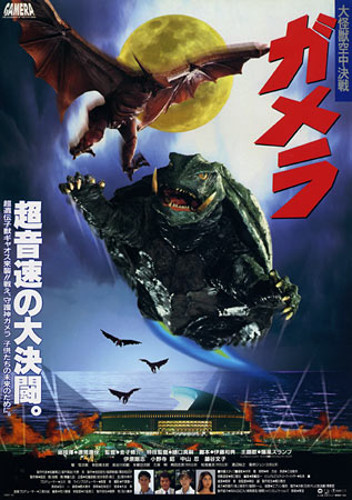
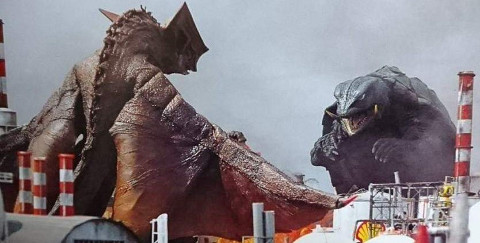
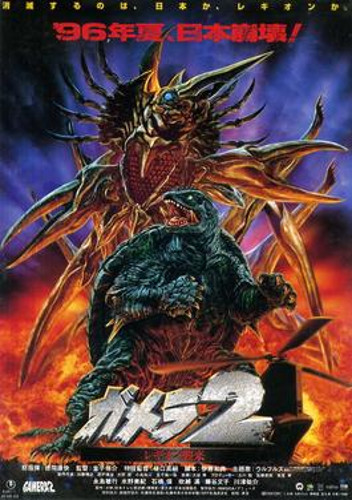

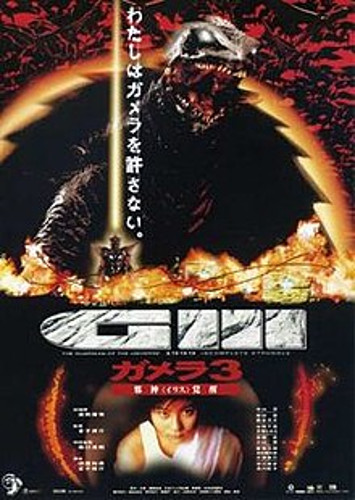

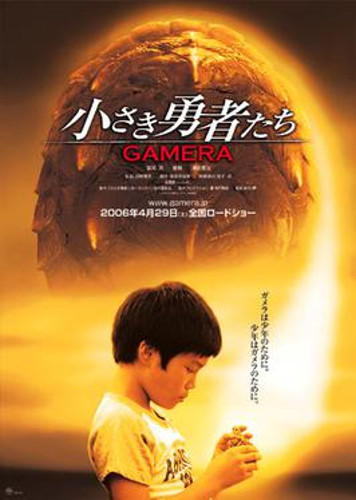
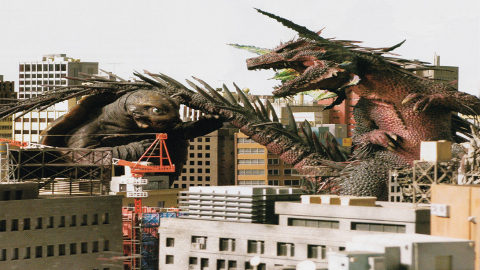


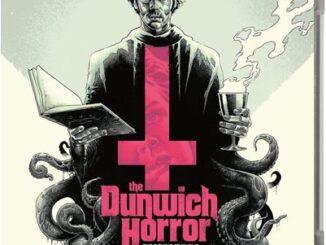

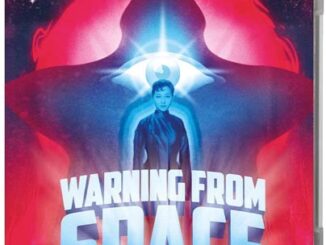
Astonishingly good trilogy; scary, funny, moving and a bit magical. It takes the craziness out of the early stuff and ramps the terror and carnage into an apocalyptic vision. Iris was reminiscent of Zulawski’s “Possession” (!) with a teenager manifesting a similarly tentacled demon out of her grief, with which she shares an unhealthy attraction; truly a disturbingly adult subject matter to be given the Kaiju treatment, but without shock or insensitivity.